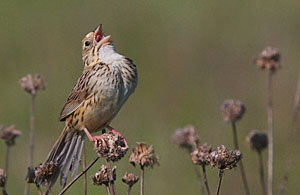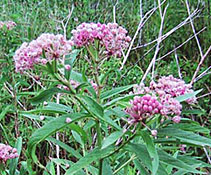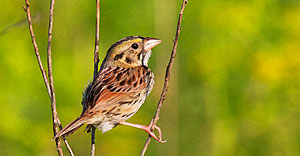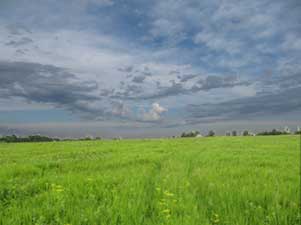An Insignificant Sparrow
Song of the Henslow's Sparrow
by Diane Porter
You could drive with the window down alongside a pasture full of singing Henslow's sparrows and never know it.
 You could hike into the field without realizing that a dozen ardent singers were throwing their heads back and pouring out their hearts in song. You could hike into the field without realizing that a dozen ardent singers were throwing their heads back and pouring out their hearts in song.
Oh, you'd notice birds. On a summer's morning, grasslands are alive with birds. Meadowlarks flute their amorous messages. The trademark songs of killdeer, bobwhites, and common yellowthroats reach you from every direction. Barn swallows race and swoop around you, and red-winged blackbirds row back and forth through the warm air, red epaulets flashing in the sunlight with each wing stroke. It's intoxicating, the color and sound and motion that fill a grassland.
I'm lucky enough to live within walking distance of such a field, which belongs to my friend and neighbor. I visit his field many spring and summer mornings. But even though I know that the field hosts Henslow's sparrows, I don't always notice them right away. Sometimes I have to stand still a while among the grasses and black-eyed susans, settle down, get quiet inside, let my mind open.
When at last I hear the whispered tslick of the Henslow's sparrow, I realize I've been hearing it all along, but it was below the threshold of my attention. My brain was selecting it out as insignificant. Once I tune in to it, I realize that there are dozens of Henslow's sparrows singing.
 Watching the tops of the grasses, I concentrate on one bird's song and search for the singer. It takes me a minute to spot him. He's balanced at the tip of a flowering milkweed that rises a little above the grass. He's farther away than I expected — his short lisp of a song has carried a considerable distance. Now that I've spotted him, my eye falls on one Henslow's after another. They pepper the field. Watching the tops of the grasses, I concentrate on one bird's song and search for the singer. It takes me a minute to spot him. He's balanced at the tip of a flowering milkweed that rises a little above the grass. He's farther away than I expected — his short lisp of a song has carried a considerable distance. Now that I've spotted him, my eye falls on one Henslow's after another. They pepper the field.
They're fairly tame. Wading through the grasses I approach a singer slowly, raising my binoculars every few steps to drink in increasingly detailed looks at the small bird. He lets me get close before he stops singing and starts to look nervous, and I stop advancing. Close enough to notice even with the naked eye how short and narrow his tail is, how flat the top of his head, how thick his bill. He decides I'm OK and starts to sing again.
 Like his song, his colors begin to appear only when I've tuned my mind to them. His back and wings are tinted with russet tones. His head has a greenish cast. Although at first glance he looked drab, with good light and a little imagination I can read this bird as red and green. Like his song, his colors begin to appear only when I've tuned my mind to them. His back and wings are tinted with russet tones. His head has a greenish cast. Although at first glance he looked drab, with good light and a little imagination I can read this bird as red and green.
I'm hearing more detail in the sparrow's song now. What sounded at first like a whispered tick unfolds into two syllables, tse-lick. The syllables loosen, and my ear registers several densely packed notes in each brief song. When I record one of the songs and analyze it on the computer, I discover that although it is only a quarter of a second long, if I slow it down to one-tenth its normal speed I hear a musical melody of seven notes.
So the song is no mere "hiccough," as slow-eared humans have described it. To the sparrows, I'm sure, every detail is clear even in real-time, full speed. They hear the boastful tale of a male and his desirable grassy territory, of his great genetic potential as a father of the next generation of Henslow's sparrows. The song matters. It has consequences. Each female listens to competing claims from males in the field and selects who will father her offspring.
 Now that I'm really listening, I hear even more compressed significance in the voice of the small bird. I hear the song of generations of Henslow's sparrows and their utter reliance on grasslands, the only place where they can live and reproduce. I hear the tale of prairie that once clothed the Midwest. I hear lyrics arguing the case for all that is beloved and irreplaceable in the natural world. Now that I'm really listening, I hear even more compressed significance in the voice of the small bird. I hear the song of generations of Henslow's sparrows and their utter reliance on grasslands, the only place where they can live and reproduce. I hear the tale of prairie that once clothed the Midwest. I hear lyrics arguing the case for all that is beloved and irreplaceable in the natural world.
How could I have missed this song, when I first walked into the grassy field? That which was so insignificant as to escape my notice is filling my ears now, rich and melodious, and my eyes are flooded with shimmering light.
That's the thing about watching birds. It's a process of learning to tune in to subtle signals, to awake to what otherwise would have gone unnoticed, to become more fully alive in the marvelous world of nature in which we live and from which we spring.
Text © 2009 by Diane Porter.
Photos of bobolink and sparrows © 2006-2012 Michael & Diane Porter.
|



